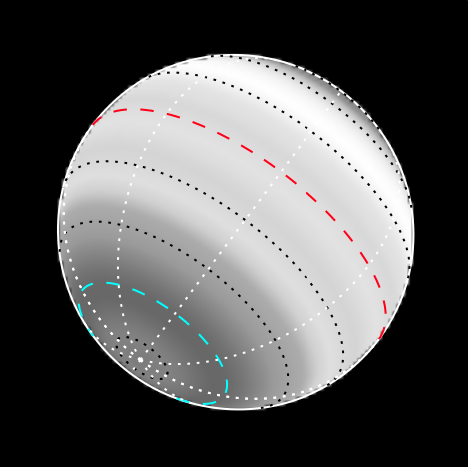Limb-darkening reanalysis of latitudinal variation of cloud-top methane abundance in Neptune's atmosphere from VLT/MUSE-NFM
- 1University of Oxford, Atmospheric, Oceanic and Planetary Physics, Department of Physics, Oxford, UK (patrick.irwin@physics.ox.ac.uk)
- 2Instituto Nacional de Técnica Aeroespacial (INTA), Spain
- 3School of Earth Sciences, University of Bristol, Wills Memorial Building, Queens Road, Bristol, BS8 1RJ, UK
- 4Department of Physics & Astronomy, University of Leicester, University Road, Leicester, LE1 7RH, UK
- 5Jet Propulsion Laboratory, California Institute of Technology, 4800 Oak Grove Drive, Pasadena, CA 91109, USA
- 6University of the Basque Country UPV/EHU, 48013 Bilbao, Spain
Observations of Neptune, made in 2018 with the Multi Unit Spectroscopic Explorer (MUSE) instrument (in Narrow-Field Adaptive Optics mode) at the Very Large Telescope (VLT) and covering the wavelength range 480 – 930 nm were previously reported by Irwin et al. (Icarus, 311, 2019). Here, these observations have been reanalysed to incorporate more effectively the effects of limb-darkening following a new approach based on the Minnaert limb-darkening model, after Pérez-Hoyos et al. (Icarus, under review, 2020). The 800 – 900 nm region of our observations includes similar strength absorption bands of methane and H2–H2/H2–He collision-induced absorption, which allows changes in cloud-top altitude to be discriminated from methane abundance variations. Splitting the background atmosphere (i.e., away from bright, discrete clouds) into latitude bands, the measured variation of reflectivity with observed zenith angle at each wavelength is fitted with Minnaert limb-darkening coefficients, which can then be used to reconstruct the expected spectrum at any angle that can then be fitted with our retrieval model, NEMESIS (Irwin et al., JQSRT, 109, 2008). We find that this approach: 1) provides much stronger constraints on the cloud structure and methane abundance; 2) makes better use of all the available data and; 3) is more computationally efficient. We find a very similar variation in cloud-top (at ~3 bar) methane mole fraction as previously reported, but with much better characterized errors, and with mole fractions diminishing from ~5% at equatorial latitudes to ~3% in the south polar region. The retrieved latitudinal distribution of cloud-top methane abundance in Neptune's atmosphere can be seen in the figure below, where Neptune's south pole is at bottom left. We show that, although the reduction of methane abundance is well constrained (i.e., reducing by a factor 5/3 from the equator to the south pole), the absolute abundances are not so well determined. This is because the retrieved methane abundance also depends on the assumed background cloud properties, for which a number of different combinations are found to provide equally good fits to the data, but differ in their retrieved methane abundances by ±1%.

How to cite: Irwin, P., Dobinson, J., James, A., Toledo, D., Teanby, N., Fletcher, L., Orton, G., and Perez-Hoyos, S.: Limb-darkening reanalysis of latitudinal variation of cloud-top methane abundance in Neptune's atmosphere from VLT/MUSE-NFM, Europlanet Science Congress 2020, online, 21 Sep–9 Oct 2020, EPSC2020-241, https://doi.org/10.5194/epsc2020-241, 2020.

